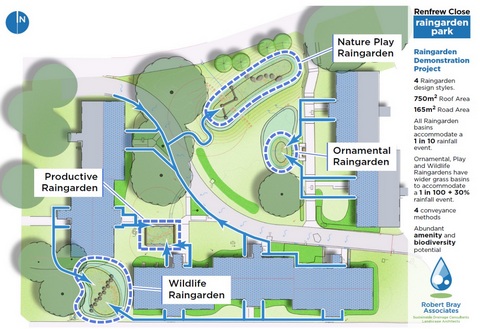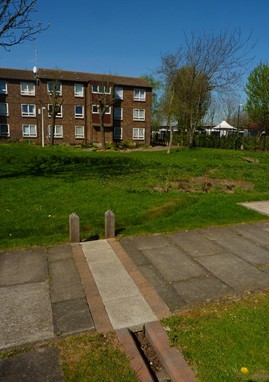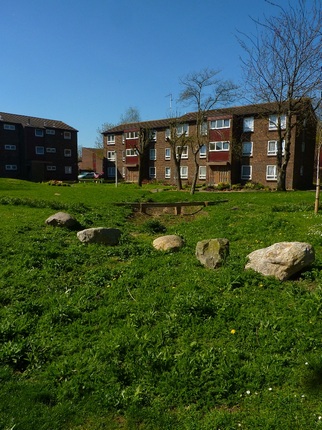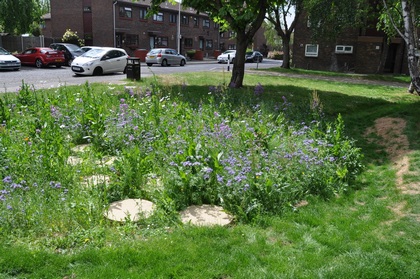Where
Renfrew Close, Beckton, London Borough of Newham, E6 5PG
Description
The Renfrew Close Rain garden is a community scale retrofit project. Renfrew Close was chosen for this project as London Borough of Newham were a willing council, who both owned the land (estate), and were supportive of this work being carried out on their land. London Borough of Newham (LBN) was also happy to pay for the maintenance costs after completion. The site also fitted funding criteria of it being a community space with a supportive community. The project was designed as a demonstration project to showcase how SuDS can be incorporated into existing areas. The system comprises four rain garden basins located within the central amenity grass areas of the surrounding social housing blocks made up of approximately thirty six flats.
The rain gardens receive water from disconnected roof downpipes and from the impermeable surfaces at ground level (through lined conveyance channels), thus reducing the volume of rainwater from the site to the sewer network.
Two of the rain gardens are sized to accommodate a 1 in 10 year rainfall event. The ‘ornamental’ rain garden is designed as 1 in 100 year +30% (to accommodate capacity for a climate change event) with a clearly defined 1 in 2 year central planted basin. The ‘productive’ rain garden is sized for a 1 in 1 year event only and was designed for use as a space for residents to grow their own food.
Main SuDS components used
-
Rain gardens
-
Shallow rainwater conveyance channel
-
Shallow detention basin
-
Conveyance channels
The overall drainage strategy is to divert storm water from the sewer system into the rain gardens through a variety of conveyance pathways. Upon reaching the rain garden basins, the water is infiltrated. During heavy rainfall it has been shown that rainwater is attenuated by the basins with connection to an overflow outlet to the sewer to provide a safe overflow in the unlikely event of design exceedance. As mentioned above, there are rain garden (figure 1), shallow rainwater conveyance channels passing under the footpath (figure 2). There is also a wider shallow grass basin sited around a central rain garden to provide additional surface water storage to increase capacity up to the 1 in 100 +30%event (figure 3). Conveyance channels comprising paving block, lined vegetated and unlined frass channels (see blue lines in figure 1). Basin 4 is designed as a wildlife garden prior to final outflow to the sewer (figure 4).

|

Figure2: Ornamental rain garden (early after installation) showing a channel bridge under a pathway. |

Figure 3: Nature play rain garden (early after installation) showing wide shallow grass basin around main rain garden basin. |
The SuDS chain incorporates existing Thames Water (TW) surface water sewer outflows as exceedance control. Water is diverted from a non-permeable area of 915m2 (750m2 roof and 165m2 road).

Figure 4: Wildlife Rain Garden leading to final outflow monitored by Thames Water. |
Rainwater is tackled directly at source by conveying the water from roof level to the rain gardens. Rainwater is conveyed at surface level from the diverted rainwater pipes to the rain gardens using a mixture of concrete block, lined grass and un-lined grass channels, these pass under pathways where necessary via shallow channel bridges with integrated overflow routes over the surface in case of blockage. Runoff from the existing block paved road is directed by an existing road gulley to a natural low point in the road, where it crosses the road in a reverse-fall grated channel. It is then carried via a grass channel to the nature play rain garden.
The site is underlaid with highly permeable soils so rain water will infiltrate into the subsurface during conveyance in the unlined channels, and infiltrate once entering the basins. This reduces the total volume of water leaving the site from hard surfaces. In extreme events this will delay the peak flow of rainwater from the site into the sewer system.
As a good practice feature three of the rain gardens are linked so that any exceedance converges to one basin which, in the absence of a natural watercourse, overflows to an existing storm water gully connection. It is anticipated that due to the designed storage capacities of the rain garden system this will happen in extreme events that exceed the design capacity of the system. The remaining 1 in 10 basin is also connected to an overflow chamber which leads to a sewer. All of the overflow connections ensure protection from exceedance flooding as a key design feature and one which should be emulated in all future SuDS projects.
Due to the high infiltration capacity of the rain gardens, the basins are likely to remain dry for most of the year. These are planted or seeded with wildflower and ornamental herbaceous mixes that are capable of tolerating both dry conditions and occasional inundation by rainwater. This makes them suitable for the demands of this particular rain garden habitat. Other projects designed to remain wetter or be able to hold standing water could include marginal or wetland species, but for this case they would not have been appropriate. The Renfrew Close basin planting considerations included infiltration rates through vigorous root structure; the ability to bind the soil through maximum plant coverage; the ability to thrive in ground conditions much like the general landscape but with occasional inundation; and to provide enhanced biodiversity, aesthetic and amenity interest for the local area far beyond that of the amenity turf that covered the area prior to the installation of the rain gardens.
Resident interaction is also encouraged through the use of stepping stones, balancing beams and a boulder feature across some of the rain garden basins. Anecdotal evidence suggests that the rain garden installations positively increase the local resident’s perception of the area.
Specific project details
The project demonstrates creative possibilities for rain garden design with a nature play rain garden incorporating balance beams and boulders to clamber on, an ornamental rain garden which brings aesthetic value, a wildlife rain garden that increases biodiversity, and a productive rain garden designed to provide residents with space to grow their own plants or vegetables. The design therefore provides an enhanced biodiversity, aesthetic and amenity interest for the local area.
As a retrofit project - the basins were designed without flow controlled drain-down outlets due to the high permeability of soils and shallow services which limited basin sizes. This allowed the basins to be connected to the on-site storm water drains for exceedance flows only (for rainfall > 1 in 10 year events for 3 basins and greater than 1 in 100 year events for 1 basin.) This may not be appropriate for other sites with differing characteristics such as lower infiltration capacity or where design will allow other methods for accommodating with exceedance flows.
Maintenance is managed by the LBN’s Greenspace team and delivered on site by the council’s grounds maintenance contractors.
Benefits and achievements
-
Creation of attractive, biodiverse, playful and productive rain gardens for the community to enjoy, whilst reducing storm water loading on existing sewers.
-
Demonstration of a range of surface conveyance methods, path crossings, planting styles and resident uses that can be applied to other raingarden projects.
-
SuDS performance monitoring being used to inform future rain garden design. The project demonstrates potential for rain gardens to reduce a development’s contribution to flooding which is applicable to both separate surface water sewer and combined sewer areas of London.
-
Introduction of the rain garden concept and a community gardening project to local residents and an adjacent primary school.
-
Successful partnership working between a Local Authority, NGO, University and Defra Arm’s Length Body.
-
Successful on site delivery using local authority framework contractors and Groundwork’s Green Team. Delivering elements of the design through their Green Team enabled unemployed residents to gain work experience and accredited qualifications in landscaping and horticulture.
As a headline monitoring figure – No water has overflown the site from the rain garden basins, thus over the first 12 months of monitoring approximately 413,214 Litres of storm water have been attenuated by the rain gardens and prevented from entering the surface water sewer.
Challenges and lessons learned
Detailed survey work (including Ground Penetrating Radar) is favourable in order to identify the presence or otherwise of services in areas of proposed excavation. This helps to avoid problems during construction, although consideration must always be given to the possibility of unforeseen underground constraints.
A main problem arose from ponding on an existing road which ran through the site but fell outside of the scope of the SuDS retrofit. Unfortunately there are still areas that pool with water during rainfall events on this road due to subsidence caused by heavy vehicle usage. Future projects should attempt as far as practicable to redirect known problem areas for ponding into their retrofit SuDS schemes where site characteristics and project budget will allow.
In planting areas adjacent to SuDS components one should always design soil levels to be below the restraining edge of a conveyance channel to avoid mulch and soil being washed into the SuDS system. At Renfrew the soil adjacent to conveyance channels featured a crowned profile to retain mulch. Initially small quantities of loose mulch and soil washed into conveyance channels and caused a degree of blockage, however this was easily removed and no evidence of conveyance channels overflowing along their integrated exceedance routes were observed. Designing for exceedance at all such interfaces is important for ensuring that flows continue to their intended destination.
Follow up surveys into local residents’ views and community engagement research would be very useful in future SuDS projects, as these can help evaluate the changing of perceptions around SuDS components over time.
Monitoring
SuDS performance monitoring is being performed by researchers from the Sustainability Research Institute at the University of East London (UEL). All rain gardens except the ‘productive garden’ are being monitored for their rain water attenuation performance.
This is realised through an innovative all-in-one system. Flow meters approximate the volume of intercepted rain water from roof level. Pressure sensors record how the basins perform during and after rain events. A remote camera trap and Thames Water (TW) V-notch weir record overflow from a 1 in 10 year basin during extreme weather events. A locally installed weather station also allows for detailed correlation between weather events and monitoring data. This system allows a response to be observed for mid-high rainfall inputs. Low flows where the pressure sensors do not record an increase in pressure following a rain event are deemed to be attenuated totally, with confirmation gained by proxy using the TW V notch weir on the site outlet which reveals whether any water has left the site.
Where possible, data is hosted publicly through a dedicated project web page (found here), where interested members of the public and local community can take a look at both archived and live data, further bolstering community engagement.
Monitoring lessons learned
-
The original equipment for flow rates from disconnected downpipes silted up after short periods of time, even on vegetation free roofs, the redesign of the equipment set up reduced this. Monitoring equipment therefore needs to be carefully designed to be both low maintenance and able to cope with future events. Creating scope within project budgets to allow for the redesign of equipment is essential to deal with unseen problems.
-
Telemetry systems for data gathering were trialled, which led to some initial confusion as queries to the service provider where often slow. Future projects must ensure that all telemetry system software are fully understood by the end user and that a system for fast responses to queries is set in place before monitoring begins.
-
Future retrofit studies should budget for research into social attitudes and engagement to further understand people’s enjoyment of SuDS features. Further methods for community feedback during the project lifetime should also be explore.
-
A site specific website can be set up in a short amount of time and at low cost. This enables sharing of data with the community and other interested parties.
Interaction with local authority
LBN has been extremely supportive of the project. A member of the Council’s grounds maintenance team has been acting as a point of contact for the project. This member of staff also visited the site with UEL researchers to hear their specific concerns over maintenance. LBN have shown a great interest in the site and have been adept at solving site maintenance problems, such as keeping conveyance channels clear of cut grass and emerging vegetation.
Key lessons for local authorities
-
Agree maintenance procedures prior to the handover of the site along with monitoring and evaluation.
-
Have a designated point of contact within the local authority to report maintenance problems to.
-
Take time to understand the SuDS system and explain maintenance needs to grounds maintenance contractors so that they manage the site sensitively.
Project details
Project completed 2015 (two year monitoring programme scheduled to complete in 2017)
Project management and community engagement costs: £15,000
Design: £9,900
Construction: £55,000
Monitoring and analysis (2015-17): £20,000
Total cost: £99,900
Project funders and partners
Environment Agency
Groundwork London
London Borough of Newham (supporting with maintenance)
Project team
Project management: Environment Agency
Design: Robert Bray Associates
Community engagement and construction: Groundwork London
Maintenance: London Borough of Newham (landowners)
Monitoring: University of east London (funded by the Environment Agency)
Monitoring equipment: RS Hydro (funded by the Environment Agency)
Other assistance: Thames Water (v-notch weir)



